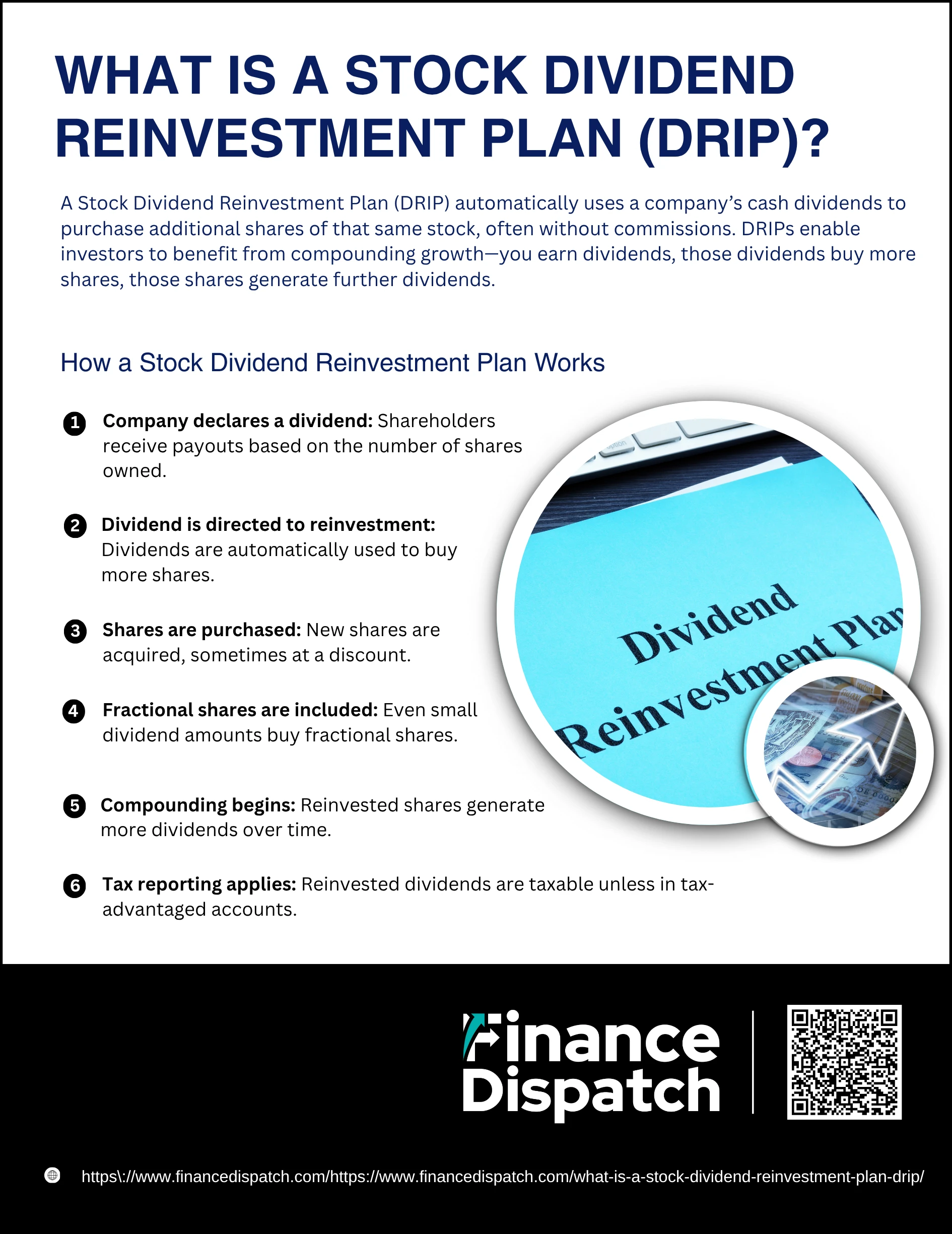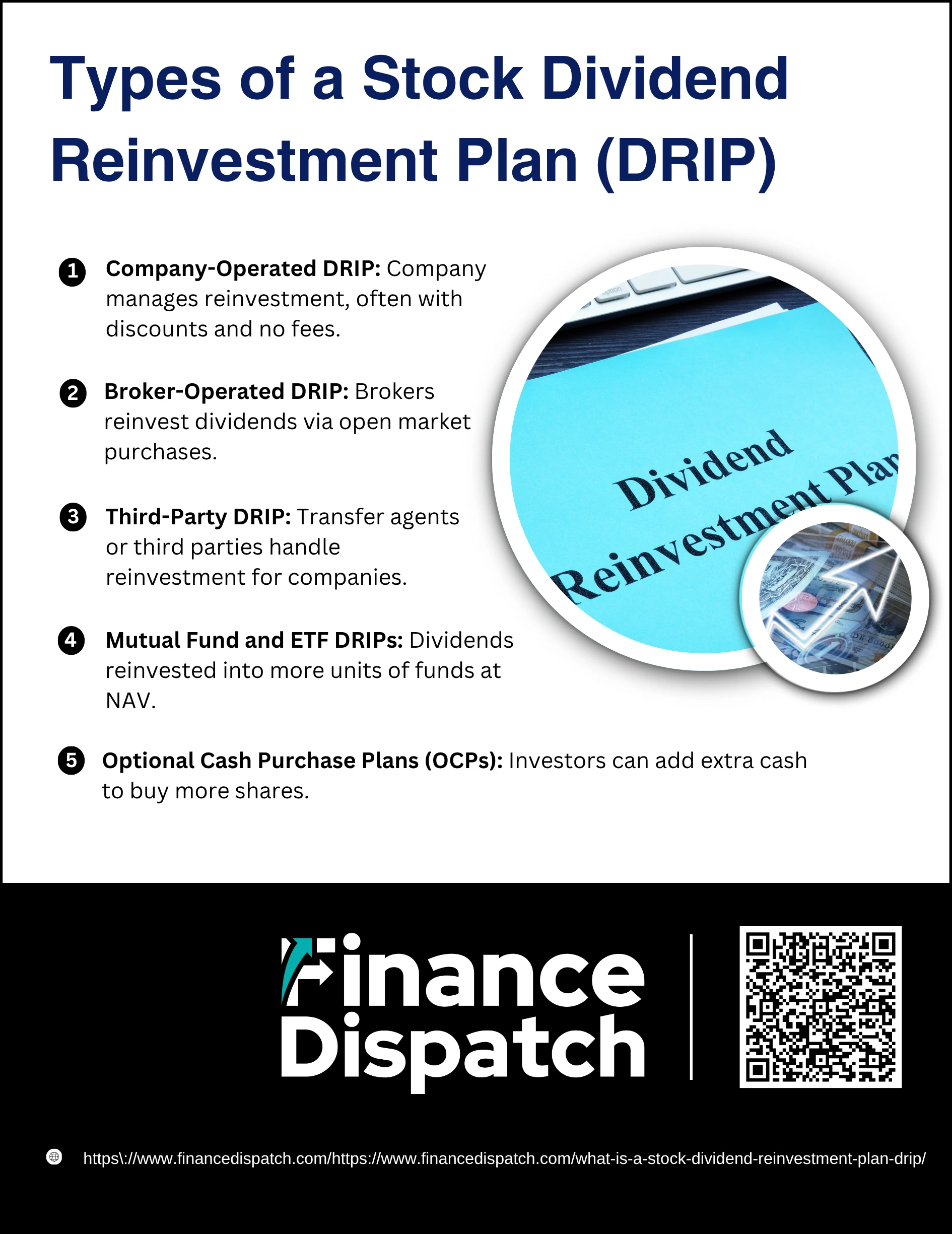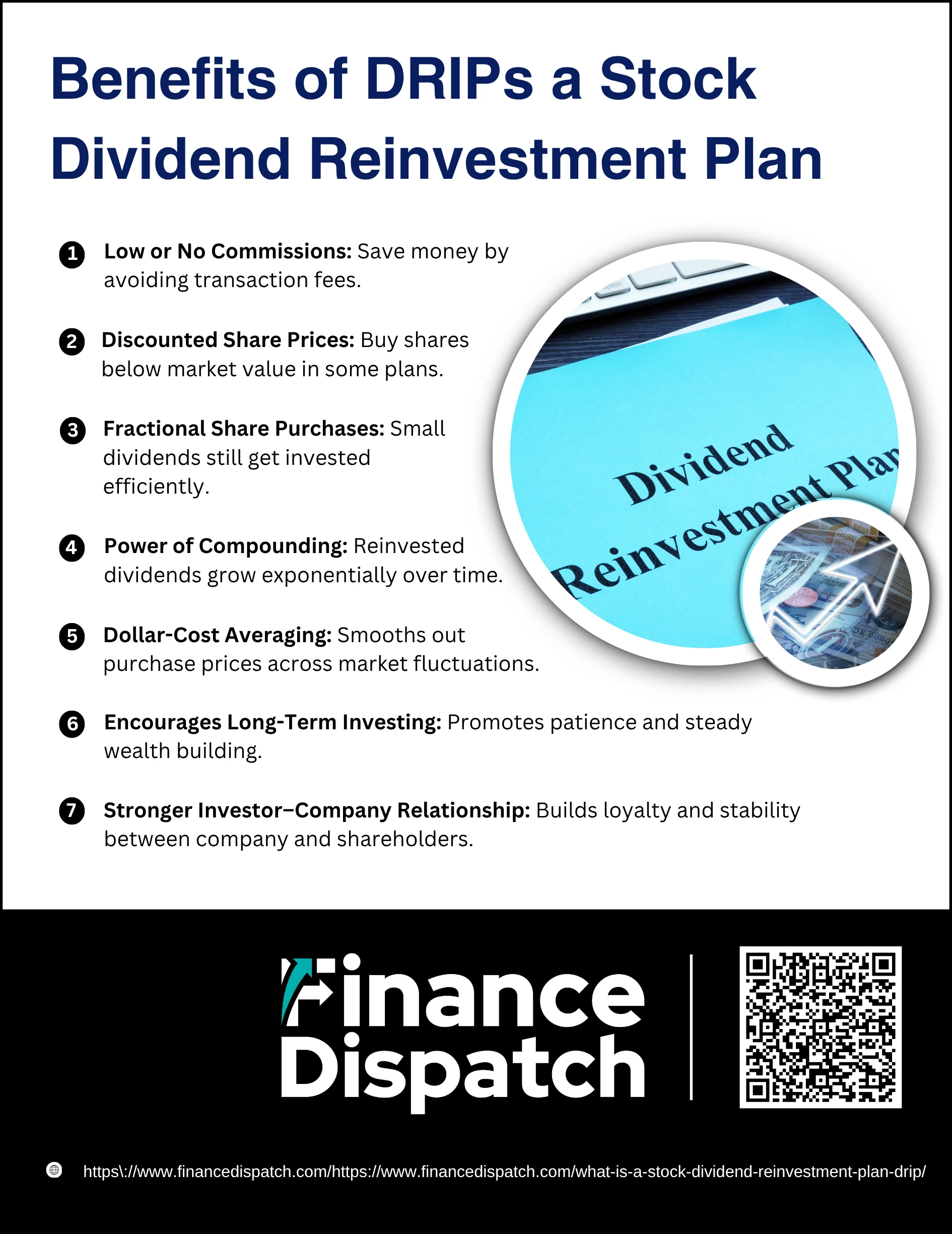When you invest in dividend-paying stocks, companies reward you with regular cash payouts. Many investors choose to pocket these payments as income, but there’s another strategy that can quietly grow your wealth over time: reinvesting those dividends. A Stock Dividend Reinvestment Plan, commonly known as a DRIP, allows you to automatically use your dividend earnings to buy more shares of the same company. This creates a powerful cycle of compounding, where each reinvested dividend generates its own future dividends, steadily expanding your holdings without requiring extra effort on your part.
A Stock Dividend Reinvestment Plan (DRIP) is a program offered by companies or brokers that lets shareholders reinvest their cash dividends into additional shares or fractional shares of stock, instead of receiving the dividend in cash. Most DRIPs are commission-free and may even allow investors to purchase shares at a discount, making them an affordable way to build wealth. Over time, these plans help investors systematically grow their ownership stake in a company, harnessing the benefits of consistent reinvestment and long-term compounding growth.
 How a DRIP Works
How a DRIP Works
Dividend Reinvestment Plans (DRIPs) are built to simplify investing while making your money work harder. Instead of taking dividends as cash, the plan automatically channels them back into buying more shares of the company. Over time, this creates a cycle where each dividend earns future dividends, fueling long-term portfolio growth through compounding.
Step-by-Step Process
1. Company declares a dividend
Every DRIP begins with a dividend announcement. When a company distributes profits to its shareholders, each investor receives a payout based on the number of shares owned. For example, if you own 100 shares and the company declares a dividend of $2 per share, you are entitled to $200 in dividends.
2. Dividend is directed to reinvestment
Instead of sending the dividend as a check or direct deposit to your bank, a DRIP redirects that money into buying more shares of the same company. This process happens automatically, so you don’t need to manually place an order each time dividends are paid.
3. Shares are purchased
The reinvested dividend amount is used to purchase new shares. Depending on the plan, these shares may come directly from the company’s reserves (company-operated DRIPs) or be bought on the open market by your broker (broker-operated DRIPs). Some plans even offer a discount on the share price, which reduces your cost of ownership.
4. Fractional shares are included
One of the major advantages of DRIPs is that they allow you to buy fractional shares. This means even if your dividend amount isn’t enough to purchase a whole share, it still gets invested. For example, if a stock is priced at $100 and you receive a $25 dividend, the plan will credit you with 0.25 shares. Over time, these fractions add up to full shares.
5. Compounding begins
Each new share you acquire also becomes eligible to earn future dividends. As those dividends are reinvested, the cycle continues. This snowball effect—where dividends generate additional dividends—is the power of compounding. The longer you stay invested in a DRIP, the more significant this compounding growth can become.
6. Tax reporting applies
Even though you don’t physically receive the dividend in cash, it is still considered taxable income in most jurisdictions. Shareholders must report these reinvested dividends when filing taxes. However, if the DRIP is held within a tax-advantaged account like an IRA or 401(k), you may defer or avoid taxes until withdrawal, making DRIPs especially attractive for retirement planning.
 Types of DRIPs
Types of DRIPs
Not all Dividend Reinvestment Plans (DRIPs) are the same. Depending on how they are offered and managed, DRIPs can vary in flexibility, cost, and convenience. Understanding the different types helps investors choose the plan that best fits their investing style and long-term goals.
Common Types of DRIPs
1. Company-Operated DRIP
In this plan, the company itself manages the reinvestment process. Dividends are used to purchase additional shares directly from the company’s reserves, often at a discount. These plans usually involve little or no commission and may offer perks such as optional cash purchases that let you buy more shares beyond just reinvested dividends.
2. Broker-Operated DRIP
If a company doesn’t run its own DRIP, many brokers offer their clients the option to reinvest dividends. In these programs, the broker purchases shares on the open market. While discounts aren’t typically available, broker-operated DRIPs are highly convenient because you can manage all your investments in one account and easily turn reinvestment on or off.
3. Third-Party DRIP
Some companies outsource their DRIP administration to transfer agents or third-party service providers. These organizations handle the reinvestment process on behalf of the company, ensuring that dividends are smoothly reinvested into additional shares. Third-party DRIPs may also include optional cash purchases, but administrative fees can vary depending on the provider.
4. Mutual Fund and ETF DRIPs
Dividend reinvestment isn’t limited to individual company stocks. Many mutual funds and exchange-traded funds (ETFs) also offer reinvestment options. In this case, dividends are automatically used to buy more units of the same fund at the prevailing net asset value (NAV), helping investors compound their returns within a diversified portfolio.
5. Optional Cash Purchase Plans (OCPs)
Some company-sponsored DRIPs provide the flexibility to contribute additional cash, not just dividends, toward purchasing shares. These purchases are often commission-free or come with minimal fees, making OCPs a cost-effective way to steadily increase ownership in a company over time.
 Benefits of DRIPs
Benefits of DRIPs
Dividend Reinvestment Plans (DRIPs) are designed to help investors grow their holdings steadily without requiring constant action. Instead of receiving dividends as cash, you automatically acquire more shares of the same company, often at little to no cost. Over time, this strategy compounds your returns and builds wealth in a disciplined, cost-effective way. Below are the main benefits of DRIPs explained in detail.
Key Benefits of DRIPs
1. Low or No Commissions
Traditional stock purchases usually come with brokerage fees or transaction charges. With a DRIP, these costs are eliminated or heavily reduced because the shares are purchased directly from the company or handled by a broker offering free reinvestment. This saves you money every time dividends are reinvested, allowing more of your capital to remain invested and working for you.
2. Discounted Share Prices
Many company-sponsored DRIPs give shareholders the added advantage of discounted share prices—sometimes 1% to 5% below the current market value. This means you’re not only saving on commissions but also buying stock at a bargain. Over the long run, a lower purchase price reduces your cost basis, increasing the potential for greater profits when you eventually sell your shares.
3. Fractional Share Purchases
One of the standout features of DRIPs is the ability to buy fractional shares. If your dividend payout is smaller than the cost of a full share, the plan automatically buys a fraction instead of letting the money sit idle. For example, if you receive $25 in dividends and the stock is priced at $100, you’ll acquire 0.25 shares. Over time, these fractions accumulate into full shares, ensuring no dollar goes unused.
4. Power of Compounding
Compounding is often called the “eighth wonder of the world,” and DRIPs make it automatic. Every reinvested dividend buys new shares, which in turn earn more dividends in future payouts. As this cycle repeats quarter after quarter, your share count—and the dividend income it generates—grows exponentially. The longer you stay invested, the more powerful compounding becomes.
5. Dollar-Cost Averaging
DRIPs reinvest dividends on every payout date, regardless of whether the stock price is high or low. This means you naturally buy more shares when the stock is cheaper and fewer shares when it’s expensive. Over time, this process smooths out your average purchase price and reduces the risk of making large investments at unfavorable market highs.
6. Encourages Long-Term Investing
Because DRIPs operate automatically, they remove the temptation to spend dividends or attempt to “time the market.” This consistency helps investors stay committed during market fluctuations. By focusing on reinvestment and compounding, DRIPs reinforce a patient, long-term investment mindset, which is often more rewarding than chasing short-term gains.
7. Stronger Investor–Company Relationship
Companies benefit when shareholders enroll in DRIPs because it provides them with steady capital inflows. At the same time, investors who join DRIPs tend to be loyal, long-term holders who are less likely to sell during downturns. This mutual commitment fosters stability and strengthens the bond between a company and its shareholders.
Potential Drawbacks of DRIPs
While Dividend Reinvestment Plans (DRIPs) can be a powerful tool for building wealth, they are not without limitations. Automatic reinvestment may not suit every investor, especially those who need cash flow or want more flexibility in their investment strategy. Understanding the potential drawbacks helps you decide whether a DRIP aligns with your financial goals.
Key Drawbacks of DRIPs
1. Taxable Income Despite Reinvestment
Even if you never see the dividend in cash, the IRS or your local tax authority still treats it as taxable income. This means you may owe taxes on money that was reinvested, potentially creating a cash flow issue if you don’t plan ahead.
2. Lack of Cash Flow
Investors who rely on dividends for living expenses or retirement income may find DRIPs inconvenient. Since all dividends are automatically reinvested, you won’t have immediate access to that cash unless you sell shares.
3. Risk of Over-Concentration
Continuously reinvesting dividends into the same company can make your portfolio overly dependent on that one stock. If the company performs poorly, your overall investment portfolio may take a harder hit due to lack of diversification.
4. Limited Control Over Purchase Timing
In a DRIP, shares are bought on the dividend payment date at the prevailing price. You don’t have the flexibility to wait for more favorable market conditions, which could result in buying shares at high valuations.
5. Complex Record-Keeping
Since each reinvested dividend creates a new purchase (often including fractional shares), you must keep track of multiple tax lots. This can make calculating your cost basis and capital gains more complicated when it’s time to sell.
6. Possible Share Dilution
Some company-operated DRIPs issue new shares rather than buying existing ones from the market. This increases the total number of outstanding shares, potentially diluting the value of each share for investors who don’t participate.
Who Should Consider a DRIP?
Dividend Reinvestment Plans are best suited for investors with a long-term outlook who want to steadily build wealth through compounding. If you don’t need immediate income from your dividends and prefer to let them grow into more shares, a DRIP can be an excellent fit. They are particularly valuable for beginners who want a simple, low-cost way to increase their holdings without actively managing every purchase. DRIPs also work well for retirement investors using tax-advantaged accounts like IRAs or 401(k)s, since taxes on reinvested dividends can be deferred. However, they may not be ideal for investors who rely on dividends as regular cash flow, or for those seeking broader diversification beyond a single company’s stock.
Real-World Example of Compounding with DRIP
To see how powerful dividend reinvestment can be, let’s look at a real-world style example. Imagine an investor who owns shares in a company that offers a DRIP with a discounted purchase price. Instead of taking dividends in cash, the investor reinvests them into new shares. Over time, this approach not only increases the number of shares owned but also boosts the future dividend income, creating a snowball effect of compounding growth.
Example: Mary’s Investment in a REIT through DRIP
| Scenario | Details | Outcome |
| Initial Holding | Mary owns 1,000 shares in a Real Estate Investment Trust (REIT). | Eligible for quarterly dividend payout. |
| Dividend Declared | $10 per share → Total dividend = $10,000. | Dividend credited on payment date. |
| DRIP Feature | Plan offers 15% discount on share price. | Reinvestment price = $85 instead of $100. |
| Shares Purchased | $10,000 ÷ $85 = ~117.6 shares. | Mary gains 117 additional shares (fraction carried forward). |
| New Shareholding | 1,000 original shares + 117 new shares = 1,117 shares. | Next dividend will be based on 1,117 shares, increasing her payout and reinvestment potential. |
Conclusion
Dividend Reinvestment Plans (DRIPs) offer a simple yet powerful way to grow your investments over time. By automatically turning dividend payouts into additional shares, they harness the benefits of compounding, reduce costs, and encourage long-term discipline. While they may not be ideal for those who depend on dividends as income or prefer more control over their investments, DRIPs can be an excellent choice for patient investors focused on steady wealth accumulation. Ultimately, deciding whether to join a DRIP depends on your financial goals, need for cash flow, and tolerance for concentration in a single stock, but for many long-term investors, they remain a proven path to building lasting value.


